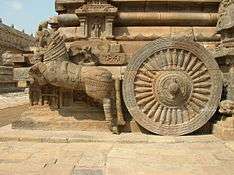Ratha Kalpana
| Part of a series on | ||
| Hindu philosophy | ||
|---|---|---|
 | ||
| Orthodox | ||
|
|
||
| Heterodox | ||
|
|
||
|
||
Ratha Kalpana (from Sanskrit ratha, meaning "chariot", and kalpana, meaning "image")[1] is a metaphor used in Hindu scriptures to describe the relationship between the senses, mind, intellect and the Self.[2][3] The metaphor was first used in the Katha Upanishad and is thought to have inspired similar descriptions in the Bhagavad Gita, the Dhammapada and Plato's Phaedrus.[4][5][6][7] Gerald James Larson, a scholar of Indian philosophies, believes that the chariot metaphor contains one of the earliest references to ideas and terminology of the Indian philosophical school Samkhya.[8]
Background
Ratha Kalpana is used, in the third chapter of Katha Upanishad, as a device to explain the hierarchy of various levels of existence. In this context, spiritual practice is seen as a return to consciousness through the levels of manifested existence.[9] The metaphor forms a part of the teaching imparted to Nachiketa, a child seeking knowledge about life after death, by Yama, the Hindu god of death.[10] It follows an instruction by Yama on the difference between preya (pleasant) and shreya (good).[11][lower-alpha 1] William K. Mahony, in The Artful Universe: An Introduction to the Vedic Religious Imagination, writes, "We have in this metaphor an image of a powerful process that can either lead to fulfillment or in which the seeker can become lost."[13]
Analogy
Verses 1.3.3–11 of Katha Upanishad deal with the allegoric expression of an individual as a chariot.[5] The body is equated to a chariot where the horses are the senses, the reins are the mind, and the charioteer is the intellect.[2] The master of the chariot is the Self, on forgetting which the charioteer intellect becomes absorbed in the field of action. The verses conclude by describing control of the chariot and contemplation on the Self as ways by which the intellect acquires Self Knowledge.[14]
He who has the understanding of the driver of the chariot and controls the rein of his mind,
he reaches the end of the journey, that supreme abode of the all–pervading— Katha Upanishad 1.3.10–11[5]
See also
References
Notes
- ↑ Easwaran writes that "these alternatives have precise Sanskrit names that have no English equivalent: preya and shreya. Preya is what is pleasant; shreya, what is beneficial. Preya is that which pleases us, that which tickles the ego. Shreya, on the other hand, has no reference to pleasing or displeasing. It simply means what benefits us".[12]
Citations
- ↑ Monier Williams Sanskrit–English Dictionary.
- 1 2 Vedanta Kesari 1967, p. 479.
- ↑ Upadhyaya 1998, p. 114.
- ↑ Izzo 2009, p. 20.
- 1 2 3 Sivaraman 1989, p. 203.
- ↑ Wynne 2007, pp. 25–26.
- ↑ Jacobsen 2008, p. 381.
- ↑ Larson 1998, pp. 96–98.
- ↑ Whicher 1998, pp. 18–19.
- ↑ Heinz 1999, p. 164.
- ↑ Easwaran 2009, pp. 45–46.
- ↑ Easwaran 2009, p. 42.
- ↑ Mahony 1998, p. 186.
- ↑ Saraswati 2002, p. 164.
Bibliography
- Easwaran, Eknath (2009), Essence of the Upanishads: A Key to Indian Spirituality, Nilgiri Press, ISBN 978-1-58638-036-6
- Heinz, Carolyn Brown (1999), Asian cultural traditions, Waveland Press, ISBN 978-1-57766-043-9
- Izzo, David Garrett (2009), The Influence of Mysticism on 20th Century British and American Literature, McFarland, ISBN 978-0-7864-4106-8
- Jacobsen, Knut A. (2008), Theory And Practice Of Yoga, Motilal Banarsidass Publ., ISBN 978-81-208-3232-9
- Larson, Gerald James (1998), Classical Sāmkhya: an interpretation of its history and meaning, Motilal Banarsidass Publ., ISBN 978-81-208-0503-3
- Mahony, William K. (1998), The Artful Universe: An Introduction to the Vedic Religious Imagination, SUNY Press, ISBN 978-0-7914-3579-3
- Monier-Williams (1960), English Sanskrit Dictionary, Oxford Clarendon Press, ISBN 978-81-206-1509-0
- Saraswati, Ambikananda (Swami.) (2002), The Uddhava Gita, Ulysses Press, ISBN 978-1-56975-320-0
- Sivaraman, Krishna (1989), Hindu Spirituality: Vedas Through Vedanta, The Crossroad Publishing Co., ISBN 978-0-8245-0755-8
- Upadhyaya, Kashi Nath (1998), Early Buddhism And The Bhagavadgita, Motilal Banarsidass Publ., ISBN 978-81-208-0880-5
- The Vedanta Kesari, Sri Ramakrishna Math, 1967, ISSN 0042-2983
- Whicher, Ian (1998), The Integrity of the Yoga Darśana: A Reconsideration of Classical Yoga, SUNY Press, ISBN 978-0-7914-3815-2
- Wynne, Alexander (2007), The Origin of Buddhist Meditation, Psychology Press, ISBN 978-0-415-42387-8

